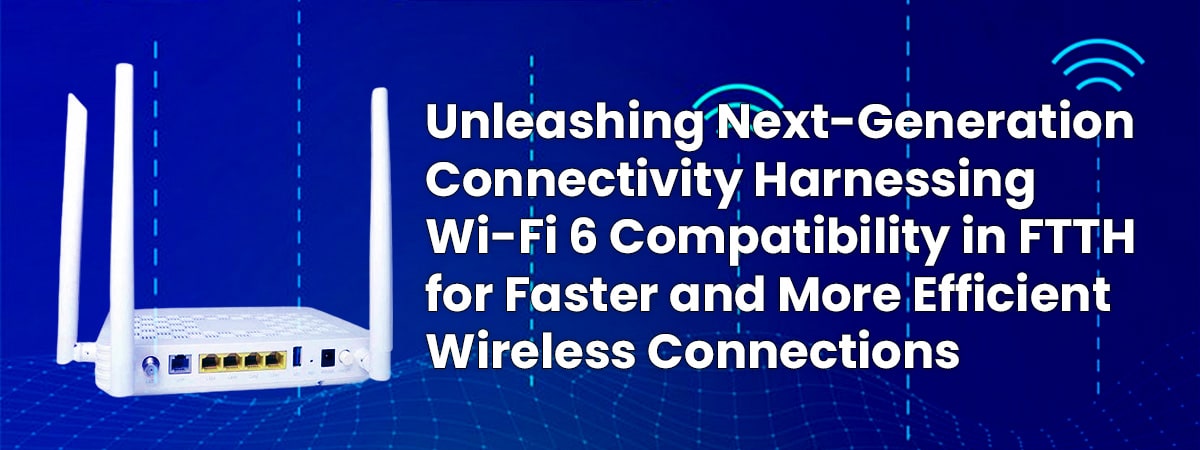Introduction:
Fiber-to-the-Home (FTTH) technology has revolutionized broadband connectivity, and now, with the integration of Wi-Fi 6 compatibility, it brings even more advancements to wireless networks. FTTH products that support Wi-Fi 6 enable users to unlock the benefits of the latest wireless standard, offering faster speeds, improved capacity, and enhanced efficiency. In this article, we explore the power of Wi-Fi 6 compatibility in FTTH, highlighting how it elevates wireless connections to a new level of performance and user experience.
Understanding Wi-Fi 6:
1.1 The Evolution of Wi-Fi Standards: Wi-Fi 6, also known as 802.11ax, is the latest generation of wireless technology, succeeding Wi-Fi 5 (802.11ac). Wi-Fi 6 introduces significant enhancements, including increased data rates, improved device capacity, reduced latency, and better performance in crowded network environments.
1.2 Key Features of Wi-Fi 6: Wi-Fi 6 incorporates advanced features such as Orthogonal Frequency Division Multiple Access (OFDMA), Multi-User Multiple Input Multiple Output (MU-MIMO), Target Wake Time (TWT), and 1024-QAM modulation. These features enhance efficiency, enable simultaneous connections, reduce interference, and boost overall network performance.
Advantages of Wi-Fi 6 Compatibility in FTTH:
2.1 Faster Wireless Speeds: FTTH products with Wi-Fi 6 compatibility offer faster wireless speeds, delivering an exceptional user experience for activities like video streaming, online gaming, and large file transfers. With higher data rates, users can enjoy seamless connectivity and reduced buffering, even with bandwidth-intensive applications.
2.2 Improved Device Capacity: Wi-Fi 6 enables more devices to connect simultaneously without sacrificing performance. With OFDMA and MU-MIMO, FTTH products can efficiently handle numerous connected devices, making it ideal for households with multiple users and smart home ecosystems.
2.3 Reduced Latency: The reduced latency in Wi-Fi 6 enhances responsiveness, especially in real-time applications like online gaming and video conferencing. With lower latency, users experience minimal delay and a more immersive and interactive online environment.
2.4 Enhanced Efficiency: Wi-Fi 6 employs advanced technologies like TWT and 1024-QAM to optimize power consumption and spectral efficiency. This results in improved battery life for devices and maximized network capacity, ensuring seamless performance across multiple devices.
Future-Proofing Connectivity:
3.1 Long-Term Compatibility: By integrating Wi-Fi 6 compatibility in FTTH products, service providers future-proof their offerings. Wi-Fi 6 is designed to support upcoming technologies and emerging applications, ensuring a seamless transition to the evolving digital landscape.
3.2 Next-Generation Applications: With Wi-Fi 6, FTTH users can fully harness the potential of emerging applications such as augmented reality (AR), virtual reality (VR), Internet of Things (IoT), and 4K/8K video streaming. These bandwidth-intensive applications demand high-performance networks, and Wi-Fi 6 delivers the necessary foundation for optimal experiences.
Conclusion:
The integration of Wi-Fi 6 compatibility in FTTH products amplifies the advantages of fiber optic connectivity by delivering faster speeds, improved device capacity, reduced latency, and enhanced efficiency. With Wi-Fi 6, users can enjoy seamless video streaming, lag-free online gaming, and smooth file transfers across a multitude of connected devices. By embracing Wi-Fi 6 in FTTH deployments, service providers ensure that their customers experience the full potential of next-generation wireless connectivity, future-proofing their networks for emerging technologies and applications.
